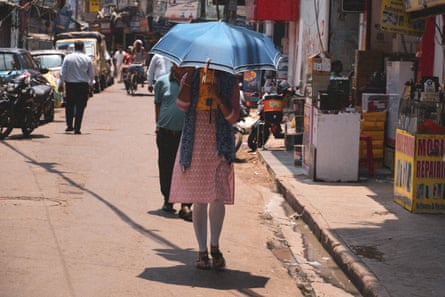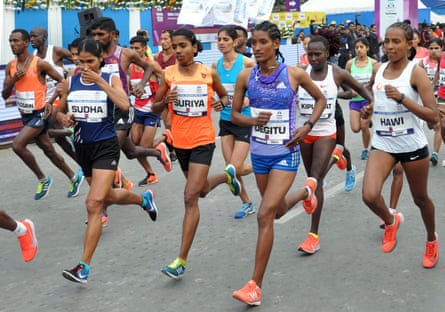
One blistering April afternoon in Kolkata, I was walking home from a reporting assignment when I felt a tap on my shoulder. “Fold your umbrella!” a man instructed as I turned, the index fingers of his hands mimicking a closing motion, “You’re taking up the space of three people.”
The Kolkata summer is savage – burning hot, witheringly humid. An umbrella is a basic, effective safeguard in this heat.
I pointed to the parked cars on both sides of the road, and the street hawkers. “Why don’t you tell them to move?”
“They aren’t blocking the way,” he said.
I was furious: a parked car has more right to public space than me? Why are women so begrudged for taking up “undue space”? And what is our “due space”?
At the time, I was in the early stages of my book on women, sport and citizenship, still unsure whether it would shape up to a fully fledged work. The man’s sense of entitlement made up mind – my amorphous idea about women and sport as an avenue to claim citizenship was worth pursuing.
Women have not always been accepted as citizens – the suffragist movements in the UK and the US tell us that. Their right to vote was earned at the end of the first world war, because women were seen as performing their national duty at a time of conflict. Sport gives women an avenue to perform nationalism outside war.
The seed of the idea had arrived four years earlier, in the winter of the Delhi gang-rape. On 16 December 2012, Jyoti Singha, 23-year-old physiotherapy student watched an evening show of Life of Pi at a multiplex in Delhi, and took a bus with her friend at about 8.30pm, where she was gang-raped by six men as the bus drove through Delhi, and then flung from the vehicle on to the streets. She died on 29 December 2012 in a Singapore hospital.
The streets of the capital, and television news studios – particularly English-language ones – convulsed with palpable anger. My own response to the Delhi gang-rape was overwhelmingly physical. I wanted to go out and physically inhabit space. I am here, I wanted to say. Get used to me.
I had started running some years earlier, when my grandma died suddenly. Grief weighed me down, and I wanted to shake it off. I lived in Delhi then and ran in the park in my upper-middle-class government-built compound. I didn’t dare run on the roads outside.
Even within the security of the compound, I was the only woman who ran. I noticed I never asked men to make way for me. Instead, I would stop running, sidle past, then run again. It disturbed my running rhythm, but what if they were annoyed by me asking them to move? I wore baggy T-shirts that I kept pulling down, and full-length bottoms – never shorts. I tried to make myself as inconspicuous as possible. I had internalised the patriarchal belief that women belong inside the home.
after newsletter promotion
But, little by little, running changed me. It made me far more aware of my body, its limits and strengths. It gave me confidence: I am more confrontational since I started running, less worried about not being liked.
Some months after I started running, when the haze of grief began to lift, I’d notice people giving way to me, sometimes even a man. Occasionally, someone would say, “Go, Usha!” PT Usha, who missed the bronze at the 400m hurdles in the 1984 Olympics by 100th of a second, is arguably India’s most notable sportswoman, and probably one of the most memorable fourth-place finishers at any Olympics.
Usha was a world-class sprinter; I put one foot after another as best as I can. There could be no comparison. But what they were reacting to was the basic act of running. Women are unwelcome in public space in the subcontinent. We got the vote in 1947 with independence, but there exists a clear threshold: our status is legitimate in the home, but in the public sphere, our position as equal citizens is far less certain. Sport offers the legitimacy to cross the threshold because it is seen as (potentially) performing for the nation.

In my book, The Day I Became a Runner, I travel the decades from the 1940s to the current moment through the lives of nine runners, and myself – a hobby runner. I chose running because it is a solitary, minimal sport: you don’t need a team, you barely need equipment. Running puts bodies on view. In that sense, it is a more direct claim to citizenship – and a more defiant challenge to patriarchy. (It is public in a way that swimming, also basic, full-body, minimal equipment, is not. Swimming takes bodies out of view.)
Most of the runners I profile in the book are elite athletes, but I close with the increasingly popular marathon ecosystem that arrived in India in the 2000s. The Mumbai marathon, India’s most prestigious race, registered 11,805 women out of 55,800 participants in 2020. The Delhi half-marathon in October this year saw more than 8,000 women out of 35,000-plus runners.
Does this mean things are improving? At the very least, these numbers speak of a certain comfort with our bodies in the public sphere. At the same time, India placed 122 out of 191 countries in the most recent UNDP index on gender inequality.
How much, then, has changed meaningfully for women? I find myself returning to a sequence in the Iranian film, The Day I Became A Woman, a triptych of stories about a girl on the brink of adolescence, a group of young female cyclists, and an old woman about to buy her first home. In the second film, we find the women cycling furiously, their black chadors flapping in the wind, creating the impression of a gaggle of big black birds.
Then the camera climbs overhead and, in an unforgettable shot, we see that each woman is wearing a different pair of trainers, 100 different colours grinning under their all-black uniforms. When I see photos of women running in marathons or half-marathons in India, I see a flash of that same incandescent possibility.
-
Sohini Chattopadhyay is an award-winning reporter and film critic, and the author of The Day I Became a Runner, published by HarperCollins India



